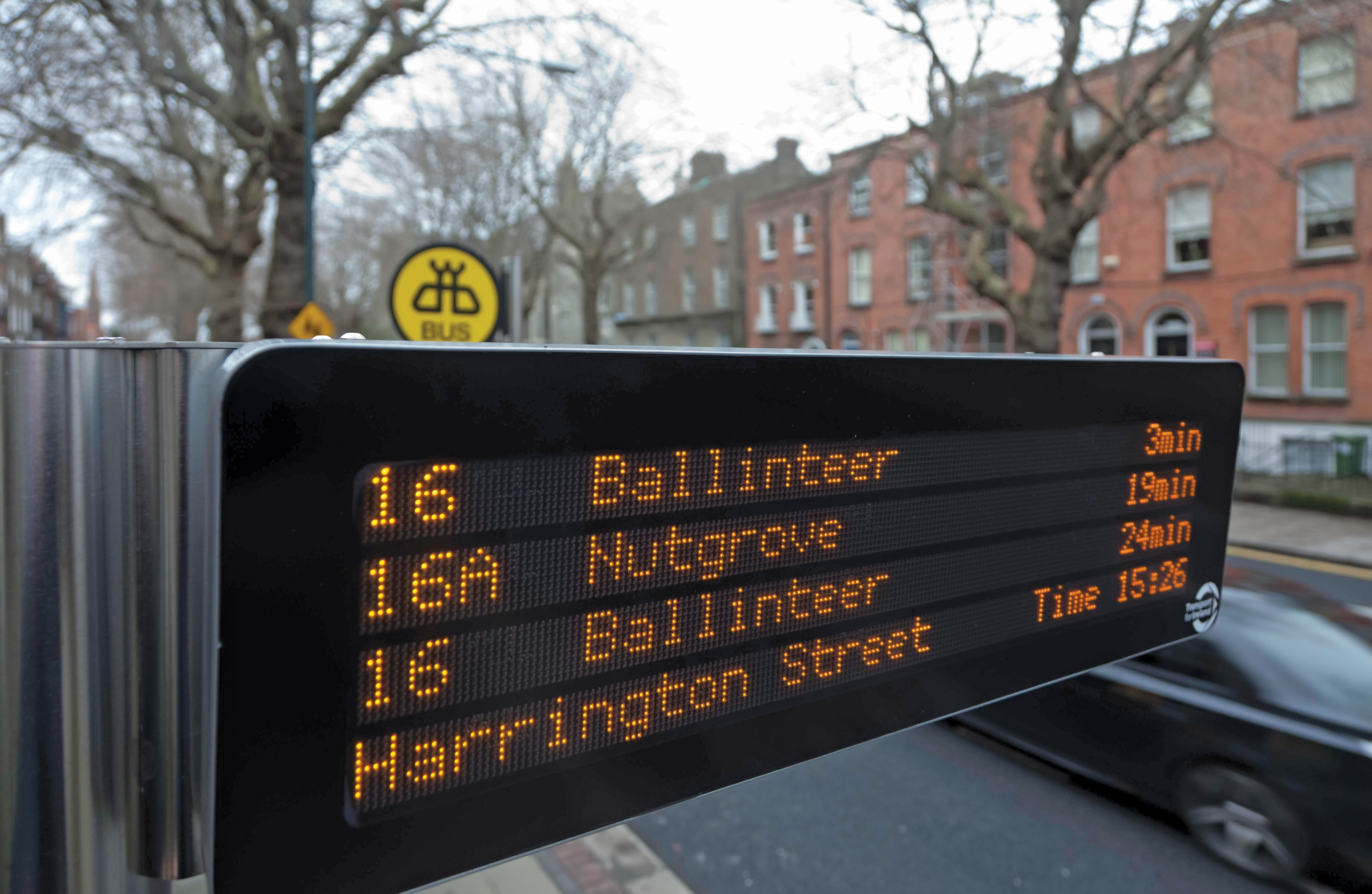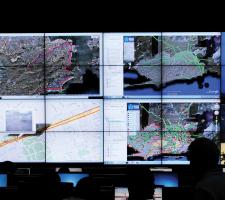
The English-language phase of a bus arrival prediction sign in Dublin
David Crawford has been to the Irish capital to see a potent memorandum of understanding at work.
An imaginative collaboration between the world’s largest IT company and one of Europe’s smaller capital cities is demonstrating a new approach to data handling that could have far reaching implications for urban public transport worldwide.A close working relationship between
IBM also had a redundant production base outside the Irish capital that was convenient in size and location for conversion into its world-first – and so far only – smarter cities research lab, which opened officially in 2011. At the same time, the Irish Government’s inward investment policy was focusing on attracting research and technology companies in general and positioning Dublin as a hub for innovation in particular.
Mutual understanding
The arrangement between the two partners is enshrined, not in a commercial agreement, but in a memorandum of understanding. This is based on the concept of exchange of available data for research purposes, with no money changing hands in either direction.So, IBM gains access to DCC’s operational bus data for use in product development, via the city’s open data platform. In return, DCC gets expert feedback from IBM researchers on the data and its uses, as well as prototype systems being developed by IBM, via the company’s open innovation platform. (This is now linked to the ‘Dublinked’ regional public data network, a pioneering initiative between the capital region’s local authorities and the National University of Ireland, Maynooth.)
The result is a data-based ITS array dedicated to supporting the city’s public transport operations. Its first outcomes are an enhanced bus service performance management capability for operators and a real-time passenger information system for travellers. It is founded on the use of affordable computational power to assimilate and process real-time information from the widest possible range of sources. It can estimate traffic conditions on the street network by fusing metrics from fixed (eg loop) and mobile (on-vehicle) detectors.
It can detect and assess service anomalies in bus operations city-wide and provide time of arrival predictions based on analysis of traffic conditions as delivered by all available sensors. The system is designed to make use of its streaming computational platform to enable travellers to be continuously updated on their progress via their smartphones.
This could, in time, include the capability for passengers – if they make it clear that they are willing to be tracked – being notified of incidents that may result in a missed connection. The information ordinarily available could possibly be amplified by crowd sourcing inputs and used to offer alternative route guidance.
Data inclusive
Central to the new approach is a decision to aggregate data at the level of road network links, rather than simply bus route level. This makes possible the inclusion of data from the city’s SCATS (Sydney Coordinated Adaptive Traffic System) array, which controls signals at over 600 intersections, to identify the risk of congestion.The system can also check recordings from GPS equipment installed for automatic vehicle location (AVL) on 1000 vehicles of the state owned Dublin Bus company using a single server. These vehicles transmit their positions on average three times every minute as they service a network of nearly 4750 stops, to feed an array of newly-installed bilingual (English and Gaelic) passenger information signs.
IBM has successfully tested deployment of the system for DCC with live data conforming to the SIRI real-time public transport information exchange standard. In surveys of Dublin Bus users, the availability of more accurate real-time information has contributed to improving public perceptions of service reliability – from 30% in 2009 to 53% in 2012. A specific July 2012 survey showed the Dublin Bus system operating at an average of 95% accuracy within three minutes and 91% within 60 seconds. (The country’s National Transport Authority is currently working on plans to bring Bus Éireann, which runs bus and coach services outside Dublin, up to the same level of accuracy.)
Challenges
IBM’s approach focuses on the challenges inherent in creating a system that is both powerful and flexible enough to cope with a growing range of demands for travel information from large and dispersed user communities. The range and capacity of sensor types is continuously growing – such as in the form of mobile phones in travel flow and speed measurement – as is the volume of data that they generate. The processing of the resulting output in real time to serve even a medium-sized city can involve analysing millions of movement points per second.At the same time, the expansion in available sensor technologies can increase the risk of some data emerging from faulty or less than accurate sources. Again, the data necessary for bus information has to be integrated satisfactorily into the context of the road network being used by services.
Not least, there is the size and cost of the computational infrastructure that would normally be needed.
Responses
IBM’s response is its InfoSphere Streams scalable processing platform, which has been applied in a specific way for DCC. The platform has been developed to take in large amounts of data from a range of sources and deliver rapid updates at reasonable cost. Key elements are the ability to process real-time AVL data, generate relevant statistics and carry out locational analyses to meet user information needs.Among further developments now on the way is a bilingual smartphone app, designed to cover not just Dublin Bus, but also Bus Éireann, the Luas Dublin tram network and Irish Rail mainline services. A soft release planned for the end of 2012 is due to be followed by general release for early 2013. An API for app developers is scheduled for delivery during the first half of next year.
Future possibilities include the inclusion in the service of weather information – historical and forecast – to refine incoming information streams. The thinking behind this is that the quality of these is in any case being affected by road surface and visibility conditions. The ability to allow in advance for any resulting weather-induced bias could therefore mean further improvements in the accuracy of travel information. But DCC has as yet put in place no time frame for this enhancement.
Meanwhile, the city is upgrading its existing traffic control into a traffic and emergency operations centre equipped to handle sub-major incidents. IBM has already, under its Smarter Cities Challenge initiative, implemented a larger-scale public information management centre for the city government of Rio de Janeiro, in Brazil, which has succeeded in cutting disaster response times from 40 minutes to 10.












